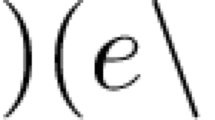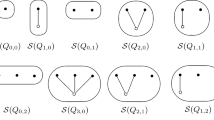Abstract
The dominion of a subalgebra H in an universal algebra A (in a class \(\mathcal{M}\)) is the set of all elements \(a \in A\) such that for all homomorphisms \(f,g:A \to B \in \mathcal{M}\) if f, g coincide on H, then af = ag. We investigate the connection between dominions and quasivarieties. We show that if a class \(\mathcal{M}\) is closed under ultraproducts, then the dominion in \(\mathcal{M}\) is equal to the dominion in a quasivariety generated by \(\mathcal{M}\). Also we find conditions when dominions in a universal algebra form a lattice and study this lattice.
Similar content being viewed by others
Explore related subjects
Discover the latest articles and news from researchers in related subjects, suggested using machine learning.References
Bergman, G. M., ‘Ordering coproducts of groups and semigroups’, J. Algebra 133:313–339, 1990.
Budkin, A. I., ‘On maximal quasivarieties groups’, Algebra i Logika 37: 279–290, 1998 (Russian).
Budkin, A. I., ‘On coatoms in lattices of quasivarieties of algebraic systems’, Algebra Universalis 46:15–24, 2001.
Budkin, A.I., and V. A. Gorbunov, ‘On the theory of quasivarieties of algebraic systems’, Algebra and Logic 14:73–84, 1975. (Translated from Russian: Algebra i Logika 14:123–142, 1975).
Gorbunov, V. A., Algebraic Theory of Quasivarieties, Consultants Burear, New York, Plenum Publishing Comporation, 1998.
Hall, P., ‘Finiteness conditions for soluble groups’, Proc. London Math. Soc. 4:419–436, 1954.
Higgins, P. M., ‘Epimorphisms and amalgams’, Colloq. Math. 56: 1–17, 1988.
Isbell, J. R., ‘Epimorphisms and dominions’, Proc. of the Conference on Categorical Algebra, La Jolla 1965, Lange and Springer, New York, 1966 (The statement of the Zigzag Lemma for rings in this paper is incorrect. The correct version is in [9]).
Isbell, J. R., ‘Epimorphisms and dominions’ IV, J. London Math. Soc. 1: 265–273, 1969.
Kargapolov, M. I., and Yu. I. Merzlyakov, Fundamentals of the Theory of Groups, Springer-Verlag, 1979.
Magidin, A., ‘A generalized argument for dominions in varieties of groups’, arXiv: math.GR/9807115.
Magidin, A., ‘Nonsurjective epimorphisms in decomposable varieties of groups’. To appear in Algebra Universalis.
Magidin, A., ‘Dominions in varieties generated by simple groups’. To appear in Algebra Universalis.
Magidin, A., ‘Words and Dominions’, arXiv:math.GR/9807120.
Magidin, A., ‘Absolutely closed nil-2 groups’, Algebra Universalis 42: 61–77, 1999.
Magidin, A., ‘Dominions in finitely generated nilpotent groups’, Comm. Algebra 27:4545–4559, 1999.
Magidin, A., ‘Dominions in decomposable varieties’, Algebra Universalis 43: 217–232, 2000.
Magidin, A., ‘Dominions in varieties of nilpotent groups’, Comm. Algebra 28: 1241–1270, 2000.
Magidin, A., ‘Amalgams of nilpotent groups of class two’, arXiv:math.GR/0105233.
Mal’tsev, A. I., ‘Quasiprimitive classes of abstract algebras’, Docl. Akad. Nauk SSSR 108:187–189, 1956 (Russian).
Mal’tsev, A. I., Algebraic systems, Nauka, Moskow, 1970 (Russian) (English translation in Springer-Verlag, 1973).
Mitchell, B., ‘The dominion of Isbell’, Trans. Amer. Math. Soc. 167: 319–331, 1972.
Saracino, D., ‘Amalgamation bases for nil-2 groups’, Algebra Universalis 16: 47–62, 1983.
Scheiblich, H. E., ‘On epics and dominions of bands’, Semigroup Forum 13: 103–114, 1976/77.
Wasserman, D., Epimorphisms and dominions in varieties of lattices, Ph.D.thesis, University of California at Berkeley, May 2001.
Author information
Authors and Affiliations
Additional information
Special issue of Studia Logica: “Algebraic Theory of Quasivarieties” Presented by M. E. Adams, K. V. Adaricheva, W. Dziobiak, and A. V. Kravchenko
Rights and permissions
About this article
Cite this article
Budkin, A. Dominions in quasivarieties of universal algebras. Stud Logica 78, 107–127 (2004). https://doi.org/10.1007/s11225-005-7127-1
Received:
Accepted:
Issue Date:
DOI: https://doi.org/10.1007/s11225-005-7127-1




